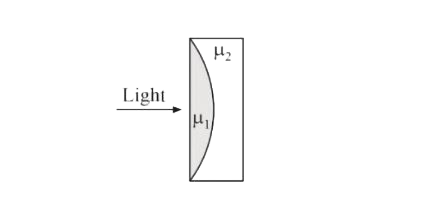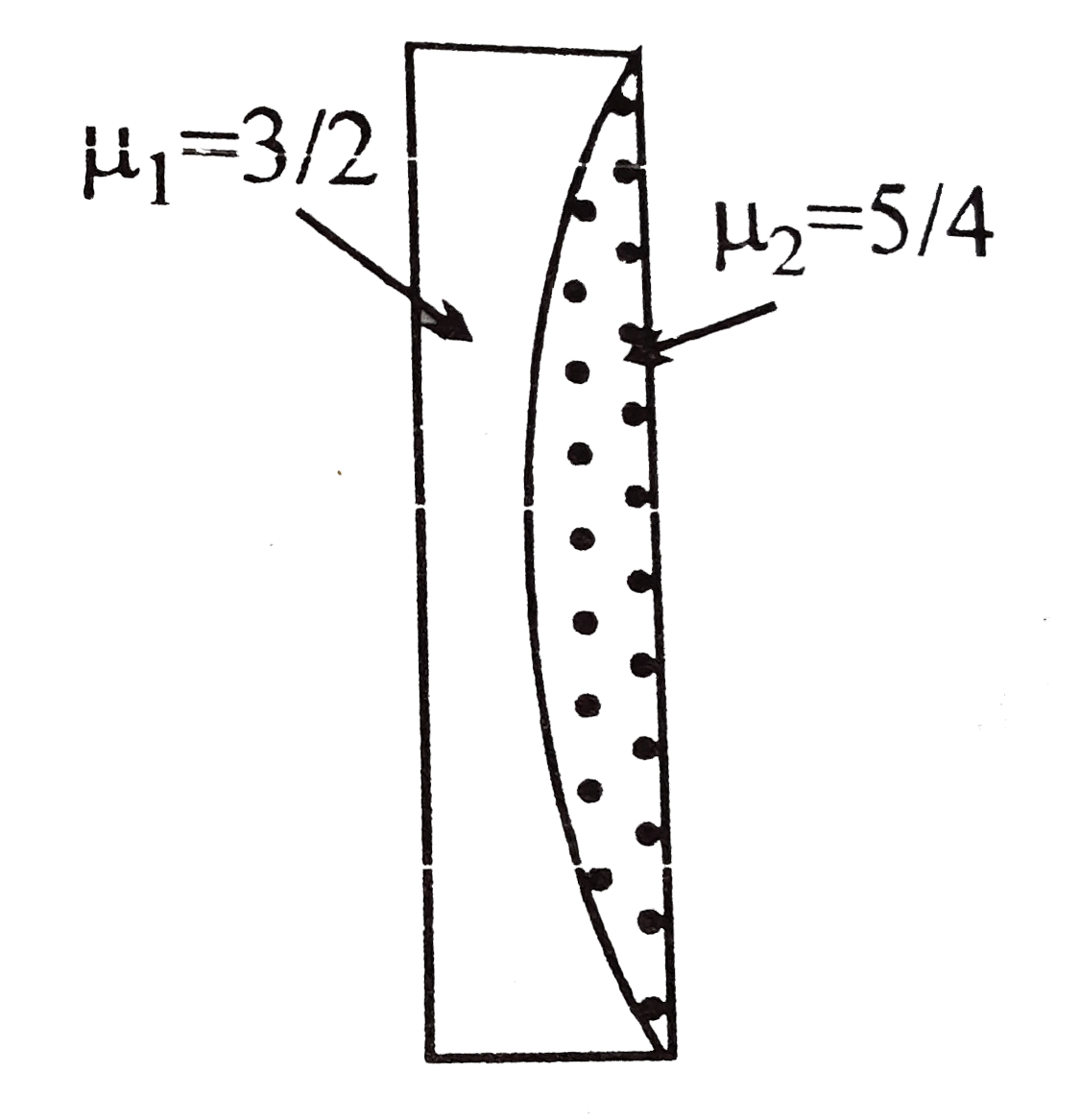A thin plano-convex lens fits exactly into a thin plano-concave lens. Their plane surfaces are parallel to each other. The lenses are made of different material of refractive indices μ1 and μ2 and R is the radius of curvature of the curved surfaces of the lenses, if rays are incident parallel to principal axis on lens of refractive index.
μ1 then the focal length of the combination is Rμ1−μ2
μ2 then the focal length of combination is 2Rμ2μ1
μ1 then the focal length of the combination is R2(μ1−μ2)
μ2 then the focal length of the combination is R(μ2−μ1)
The correct Answer is:A, D
To solve the problem regarding the equivalent focal length of a thin plano-convex lens and a thin plano-concave lens, we will use the lens maker's formula and the concept of equivalent focal lengths for lenses in combination.
1. Identify the Lenses and Their Properties:
- We have a plano-convex lens with refractive index μ1 and a plano-concave lens with refractive index μ2.
- The radius of curvature for both lenses is R.
2. Lens Maker's Formula:
- The lens maker's formula for a lens is given by:
1F=(μ−1)(1R1−1R2)
- For the plano-convex lens:
- R1=R (convex surface)
- R2=∞ (plane surface)
- Therefore, the focal length F1 is:
1F1=(μ1−1)(1R−0)=μ1−1R
F1=Rμ1−1
3. For the Plano-Concave Lens:
- For the plano-concave lens:
- R1=−R (concave surface)
- R2=∞ (plane surface)
- Therefore, the focal length F2 is:
1F2=(μ2−1)(−1R−0)=−μ2−1R
F2=−Rμ2−1
4. Calculate the Equivalent Focal Length:
- When the two lenses are combined, the equivalent focal length Feq is given by:
1Feq=1F1+1F2
- Substituting the values of F1 and F2:
1Feq=μ1−1R−μ2−1R
1Feq=(μ1−1)−(μ2−1)R=μ1−μ2R
- Therefore, the equivalent focal length is:
Feq=Rμ1−μ2
5. Direction of Focal Length:
- If μ1>μ2, the focal length Feq is positive, indicating a converging lens.
- If μ1<μ2, the focal length Feq is negative, indicating a diverging lens.
- We have a plano-convex lens with refractive index μ1 and a plano-concave lens with refractive index μ2.
- The radius of curvature for both lenses is R.
- The lens maker's formula for a lens is given by:
1F=(μ−1)(1R1−1R2)
- For the plano-convex lens:
- R1=R (convex surface)
- R2=∞ (plane surface)
- Therefore, the focal length F1 is:
1F1=(μ1−1)(1R−0)=μ1−1R
F1=Rμ1−1
- For the plano-concave lens:
- R1=−R (concave surface)
- R2=∞ (plane surface)
- Therefore, the focal length F2 is:
1F2=(μ2−1)(−1R−0)=−μ2−1R
F2=−Rμ2−1
- When the two lenses are combined, the equivalent focal length Feq is given by:
1Feq=1F1+1F2
- Substituting the values of F1 and F2:
1Feq=μ1−1R−μ2−1R
1Feq=(μ1−1)−(μ2−1)R=μ1−μ2R
- Therefore, the equivalent focal length is:
Feq=Rμ1−μ2
- If μ1>μ2, the focal length Feq is positive, indicating a converging lens.
- If μ1<μ2, the focal length Feq is negative, indicating a diverging lens.
Similar Questions
A plano-convex lens fits exactly into a plano-concave lens. Their plane surfaces are parallel to each other. If the lenses are made of different material of refractive indices μ1 and μ2 and R is the radius of curvature of the curved surface of the lenses, then focal length of the combination is
View SolutionA plano convex lens fits exactly into a plano concave lens. Their plane surfaces are parallel to each other. If the lenses are made of different materials refractive indices μ1 and μ2 and R is the radius curvature of the curved surface of the lenses, the focal length of the combination is
View SolutionA plano convex lens fits exactly into a plano concave lens. Their plane surfaces are parallel to each other. If the lenses are made of different materials refractive indices μ1 and μ2 and R is the radius curvature of the curved surface of the lenses, the focal length of the combination is
View SolutionA plano convex lens fits exactly into a plano concave lens. Their plane surfaces are parallel to each other. If lenses are made of different materials of refractive index μ1=4/3 and μ2=6/5 and R = 40 cm is the radius of curvature of the curved surface of the lenses, then the focal length of combination (in meters) is.
 View Solution
View SolutionA plano convex lens fits exactly into a plano concave lens. Their plane surfaces are parallel to each other. If lenses are made of different materials of refractive index μ1=4/3 and μ2=6/5 and R = 40 cm is the radius of curvature of the curved surface of the lenses, then the focal length of combination (in meters) is.
 View Solution
View SolutionA thin plano-convax lens fits exactly into a plano concave lens with their plane surface parallel to each other as shown in the figure.the radius of the curvature of the curved surface R=30cm The lens are made of different material having refractive indexμ1=32and μ2=54as shown in the figure

(i) if plane surface of the plano -convex lens is silvered,then calculate the equivalent focal length of this system and also calculate the nature of this equivalent mirror .
(ii) An object having transverse length 5cmis placed on the axis of equivalent mirror(in part1)atadistance15cm from the equivalent mirror along principal axis.Find the transverse magnification produced by equivalents mirror.View SolutionA plano-concave lens is made of glass of refractive index 1.5 and the radius of curvature of its curved face is 100 cm. What is the power of the lens?
View SolutionA planocovex lens is made of a material of refractive in μ=1.5 The radius of curvature of curved surface of the lens is 20.cm. If its plane surface3 is silvered, the focal length of the silvered lens will be
View SolutionA thin plano - convex lens acts like a concave mirror of focal length 0.2 m, when silvered on its plane surface. The refractive index of the material of the lens is 1.5. The radius of curvature of the convex surface of the lens will be
View SolutionA plano-concave lens is made of glass (R.l. = 1.5) and the radius of curvature of the curved face is 50 cm. The power of the lens is
View Solution

